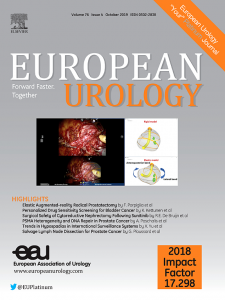Robotic-assisted Kidney Autotransplantation for Nutcracker Syndrome: Surgical Technique and Results
IF 25.2
1区 医学
Q1 UROLOGY & NEPHROLOGY
引用次数: 0
Abstract
Background and objective
The nutcracker syndrome is a rare condition that occurs in young patients and can cause severe flank pain. The available surgical techniques often carry a risk of complications or morbidity. This study aims to describe robotic-assisted kidney autotransplantation for nutcracker syndrome and show its efficacy and safety.Methods and surgical procedure
A retrospective study of all patients managed in our center by robotic-assisted kidney autotransplantation for symptomatic nutcracker syndrome was carried out. Patient demographics, operative time, hospitalization time, complications, management of postoperative pain, and patient-reported outcome measures (PROMs) were assessed.Key findings and limitations
Thirty-four patients (30 female and four male) underwent surgery between January 2015 and December 2024, with a median age of 35 (Q1–Q3: 27–43) yr and a median body mass index of 20 kg/m2. The median operative time was 314 (Q1–Q3: 265–350) min, and the median hospital stay was 3 d. One procedure was converted to open surgery. Seven patients (21%) experienced complications within 3 mo, including five minor (Clavien-Dindo grade <3) and two major (Clavien-Dindo ≥3) complications, one of which required a nephrectomy. The median follow-up was 15 (Q1–Q3: 6–30) mo. PROMs were available for 29 patients. Nine patients (31%) reported complete symptom relief, 17 (59%) partial improvement, and three (10%) partial worsening of their symptoms.Conclusions and clinical implications
Robotic-assisted kidney autotransplantation can be a therapeutic option for the treatment of nutcracker syndrome, but it should be performed in an expert center for transplantation and robotic surgery. Further studies and long-term follow-up are needed.机器人辅助肾自体移植治疗胡桃夹子综合征:手术技术和结果
背景与目的胡桃夹子综合征是一种罕见的年轻患者,可引起严重的侧腹疼痛。现有的手术技术往往有并发症或发病的风险。本研究旨在描述机器人辅助肾脏自体移植治疗胡桃夹子综合征,并证明其有效性和安全性。方法和手术方法回顾性研究了所有在本中心接受机器人辅助肾自体移植治疗症状性胡桃夹子综合征的患者。评估患者人口统计学、手术时间、住院时间、并发症、术后疼痛管理和患者报告的结果测量(PROMs)。2015年1月至2024年12月,34例患者(30例女性,4例男性)接受了手术,中位年龄为35岁(Q1-Q3: 27-43)岁,中位体重指数为20 kg/m2。中位手术时间为314 min (Q1-Q3: 265-350),中位住院时间为3 d。1例手术转为开放手术。7例(21%)患者在3个月内出现并发症,包括5例轻微(Clavien-Dindo级<;3)和2例严重(Clavien-Dindo≥3)并发症,其中1例需要行肾切除术。中位随访时间为15个月(Q1-Q3: 6-30个月)。29例患者使用PROMs。9例患者(31%)症状完全缓解,17例(59%)症状部分改善,3例(10%)症状部分恶化。结论和临床意义机器人辅助肾自体移植可作为治疗胡桃夹子综合征的一种治疗选择,但应在移植和机器人手术专家中心进行。需要进一步的研究和长期随访。
本文章由计算机程序翻译,如有差异,请以英文原文为准。
求助全文
约1分钟内获得全文
求助全文
来源期刊

European urology
医学-泌尿学与肾脏学
CiteScore
43.00
自引率
2.60%
发文量
1753
审稿时长
23 days
期刊介绍:
European Urology is a peer-reviewed journal that publishes original articles and reviews on a broad spectrum of urological issues. Covering topics such as oncology, impotence, infertility, pediatrics, lithiasis and endourology, the journal also highlights recent advances in techniques, instrumentation, surgery, and pediatric urology. This comprehensive approach provides readers with an in-depth guide to international developments in urology.
 求助内容:
求助内容: 应助结果提醒方式:
应助结果提醒方式:


